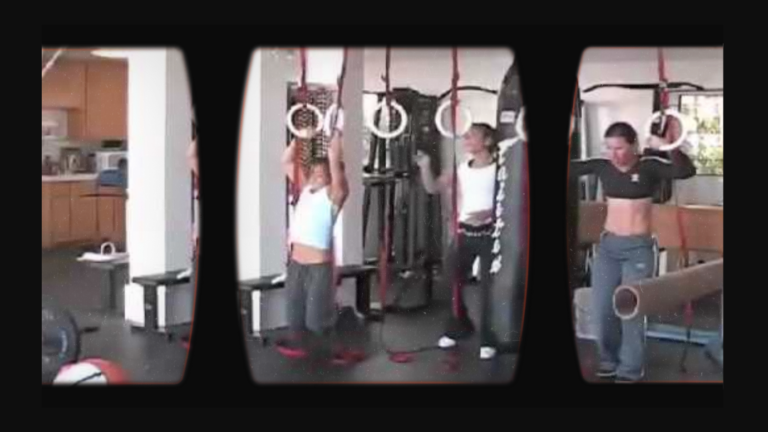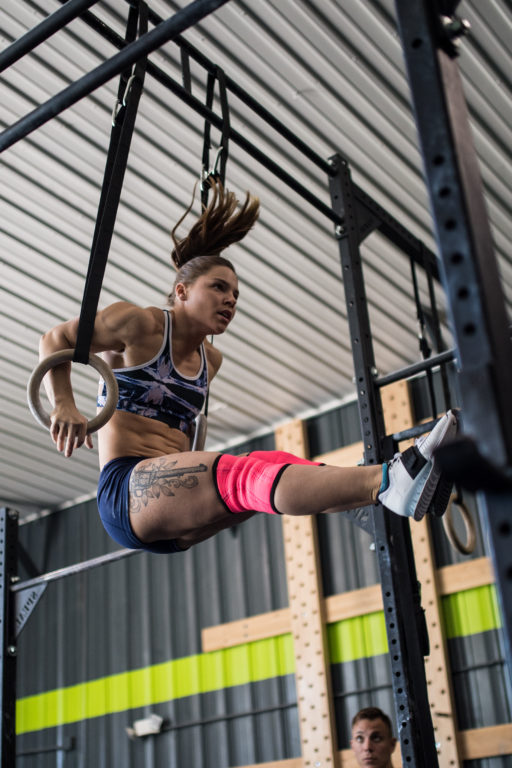 On Dec. 4, 2005, the following workout appeared on CrossFit.com:
On Dec. 4, 2005, the following workout appeared on CrossFit.com:
3 rounds for time of:
50 squats
7 muscle-ups
135-lb hang power cleans, 10 reps
With the post appeared a link to this video (uploaded to YouTube in 2011), featuring Nicole Carroll, Eva “T” Twardokens, and Annie Sakamoto completing the workout, which would later be dubbed “Nasty Girls.” If you’re watching it for the first time now, you likely have no idea just how revolutionary it was.
At the time, CrossFit itself, in its infancy, was seriously counterculture — and counter-industry, you might say.
“Traditional physical training (PT) and mainstream fitness had been stripped of skill-based movements … movements requiring flexibility, accuracy, agility, coordination, and balance,” Carroll, now CrossFit’s GM of Training and Education, wrote. “The result was twofold: 1) people were not being afforded an effective way to get fit, and 2) strict strength, i.e., contractile potential, being the primary gold standard, only served to widen the apparent gap between the physical capability of men and women.”
In a fitness world dominated by lat pull-downs and leg extensions, CrossFit preached functional movements executed at high intensity. And we said anyone could do them.
“But when you bring moves/standards that require more skill and equate to more well-rounded capacity, this gap narrows,” Carroll continued.
In the video, not only do all three women complete 30 hang power cleans at 95 lb — a moderate load for the time — but they also perform 21 muscle-ups. Carroll did her first 6 reps unbroken — and she did them strict.
For context: Even today, women don’t compete in ring events at the Olympics (for a brief window from 1948-1950, they did; why the rings were stripped from female competition afterward is enough to confound any CrossFit athlete).
“Apparently, women did not do muscle-ups, or anything else on the rings for that matter,” Carroll reflected, “but no one had told us that. So we just did them. A lot of them.”
Sakamoto finished the workout in 9:47; Twardokens at 10:16. After an agonizing skirmish with the final 10 reps, Carroll stopped the clock at 12:51.
“From the beginning, whether male or female, people’s capabilities (physical and intellectual) were not underestimated,” she wrote. “Genuine hard work — meeting the challenges at hand with all your effort — was valued above everything else. Differences were not denied and neither was special exception offered because of them. Instead, limits simply were not set — not on expectation or opportunity — thus making way for infinite possibility.”
The feat served as a call to arms for those who’d been misguided by the fitness industry; the video — with more than half a million views to date on YouTube alone — undeniably inspirational.
“You had female athletes doing things that even very few males in the community could do at that time,” Carroll wrote in an email interview. “I think this spoke volumes to the efficacy of the program. It opened the door to possibility for men and women alike. Like, ‘Holy shit, this CrossFit thing can make monsters out of the 5-foot-tall pottery teacher and aerobics instructor from Santa Cruz — imagine what it could do for me.”
But CrossFit athletes do more than dream. They train.

Sheila Barden performs muscle-ups in preparation for competition in 2017 — Photo by Ginnie Coleman
Since its debut 17 years ago, Nasty Girls has been programmed on CrossFit.com nine times. In 2006, times posted to CrossFit.com ranged from just over 10 minutes to well over 30. In 2013, the workout’s most recent appearance until today, most posted times were sub-20 minutes.
In 2014, Nasty Girls V2 was programmed for the individual regional competition:
3 rounds:
50 single-leg squats
7 muscle-ups
10 hang power cleans (175/115 lb)
The slowest women’s time for that event was 19:21. The fastest — set by Sheila Barden out of the North East Regional — was 6:54.
The performances were a testament to the work being done in affiliates and in garages around the world every day.
“Look around your gym to see all the female athletes annihilating muscle-ups, hang cleans, and every movement in between,” said James Hobart, Seminar Staff Flowmaster (CF-L4). “Look at how far the entire CrossFit community has come regarding fitness and training knowledge because of videos like this and athletes like Annie, Nicole, and Eva T.”
Today, Nasty Girls is lauded as one of CrossFit’s most venerable benchmark workouts, an iconic test for all those who wish to reckon with their fitness.
“Muscle-ups will punish you if you are well conditioned but sleeping on your skills,” Hobart said. “If you are the strongest person in the room but always lollygag the workouts, then the volume puts you out. Benchmark workouts feel like getting chased by the boogeyman; there is nowhere to hide. And if that isn’t motivating enough, just remember that three women were crushing your time and doing this workout 17 years ago.”
“It’s a wonderfully elegant workout,” Carroll added, noting how the muscle-ups and cleans complement each other — a pull from above and a pull from below — while the air squats keep the heart rate high.
“This workout is also technically demanding and rewards sound technique — the cleaner your movement, the faster you will go,” she said.
But there’s one thing that matters more than your time or whether you can fly atop the rings at all: effort. Take it from the “Nasty Girl Who Cried” herself.
“I was very nervous to start and very bummed at the end because I felt as though I had failed or lost,” Carroll said. “I had no idea how the community would rally behind the effort. This was, for me, the first realization/experience of the broader culture that was being created — that is, a safe place to push yourself.”
Comments on Nasty Girls — A Retrospective
I love this video it’s crazy the difference in the skills, the fact they do MU’s strict, the pure speed of the air squats, I thought it was on fast forward the first time I saw it, the difficulty in the BB, the determination to finish, it’s such a classic and so great to see circulated again
Great article! Always a good reminder to examine the events that made this thing what it is today
Nasty Girls — A Retrospective
2